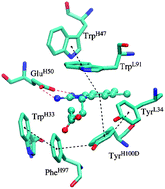OMx-D: semiempirical methods with orthogonalization and dispersion corrections. Implementation and biochemical application†
Abstract
The semiempirical methods of the OMx family (orthogonalization models OM1, OM2, and OM3) are known to describe biochemical systems more accurately than standard semiempirical approaches such as AM1. We investigate the benefits of augmenting these methods with an empirical dispersion term (OMx-D) taken from recent density functional work, without modifying the standard OMx parameters. Significant improvements are achieved for non-covalent interactions, with mean unsigned errors of 1.41 kcal/mol (OM2-D) and 1.31 kcal/mol (OM3-D) for the binding energy of the complexes in the JSCH-2005 data base. This supports the use of these augmented methods in quantum mechanical/molecular mechanical (QM/MM) studies of biomolecules, for example during system preparation and equilibration. As an illustrative application, we present QM and QM/MM calculations on the binding between antibody 34E4 and a


 Please wait while we load your content...
Please wait while we load your content...